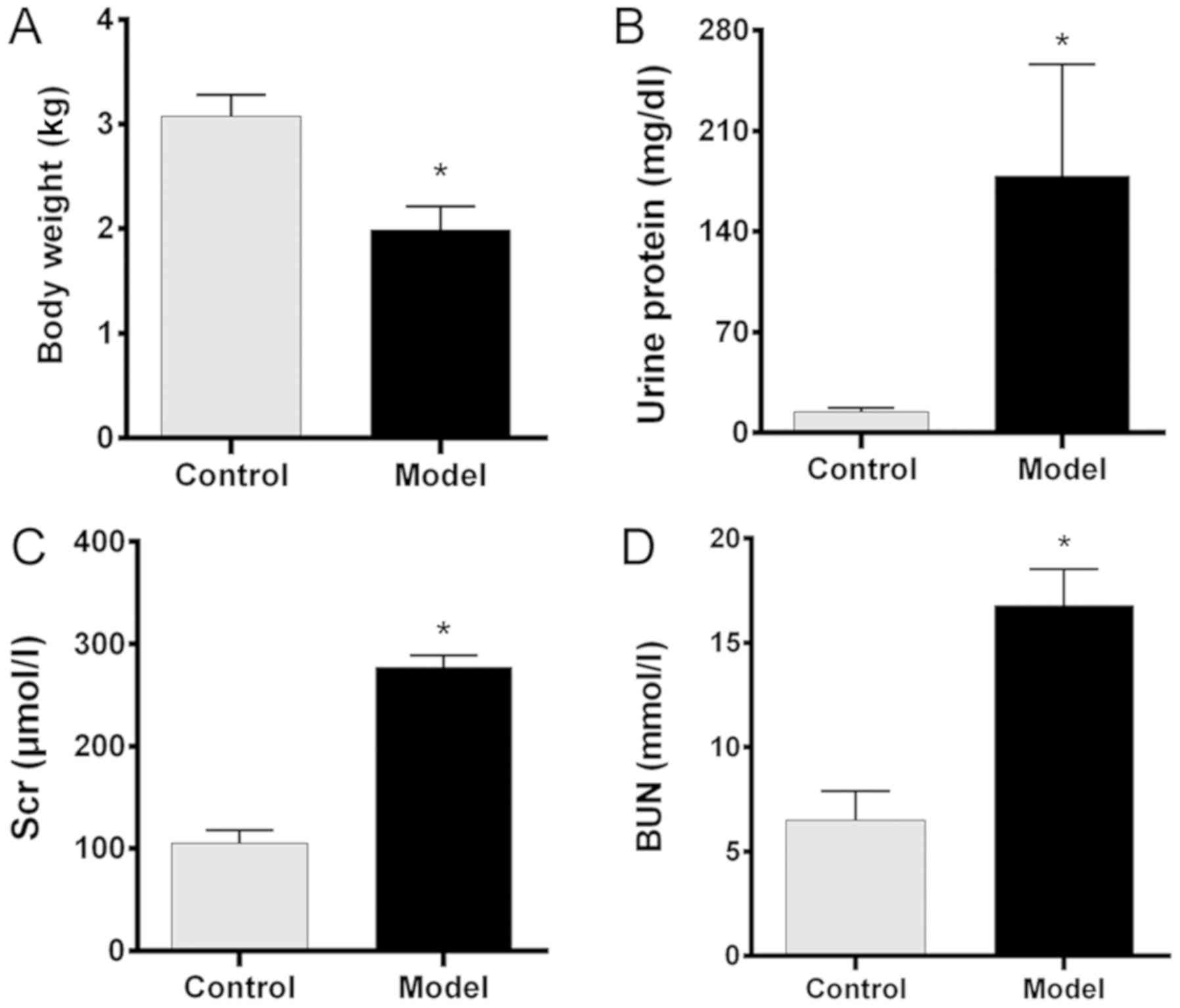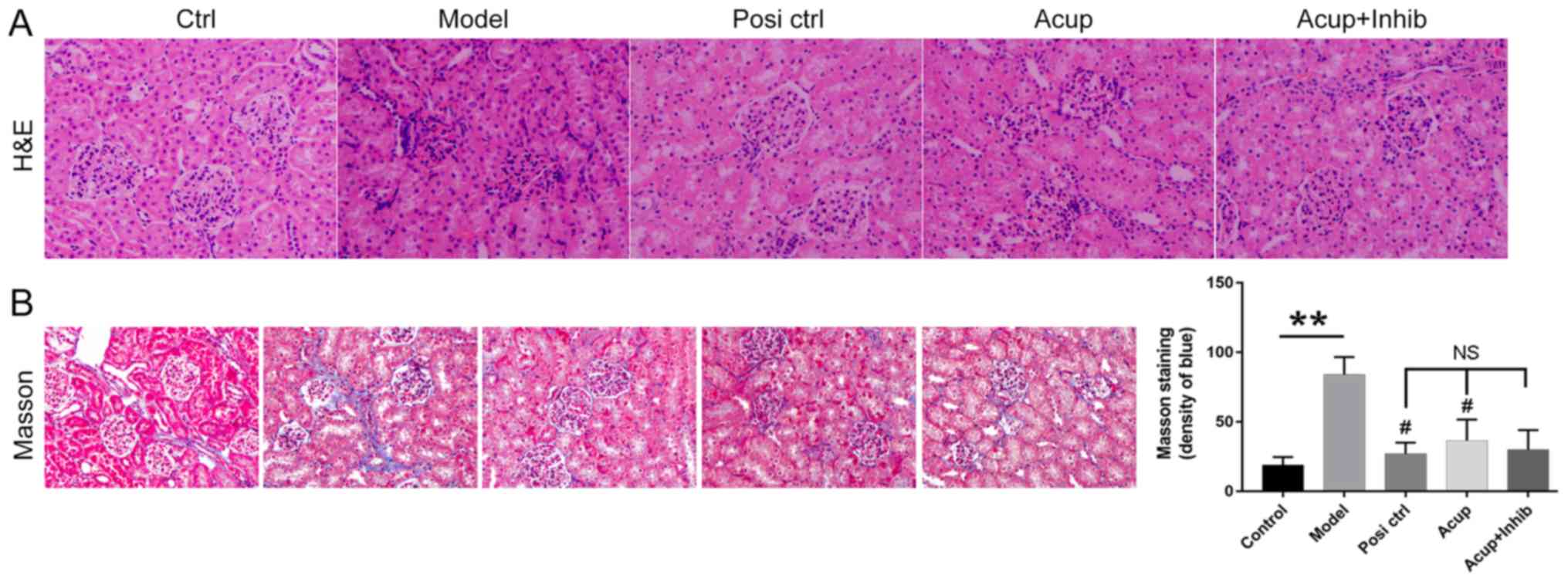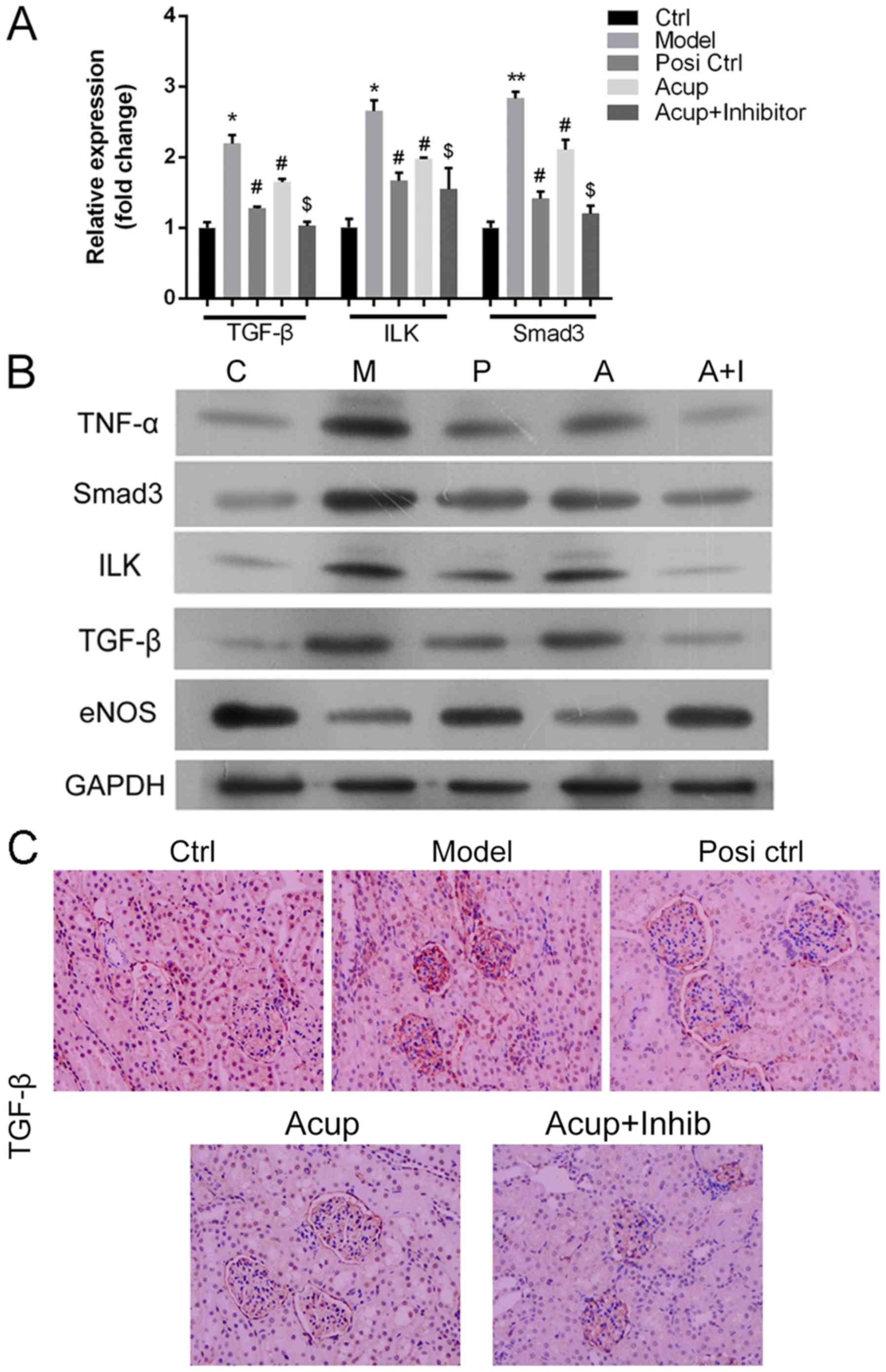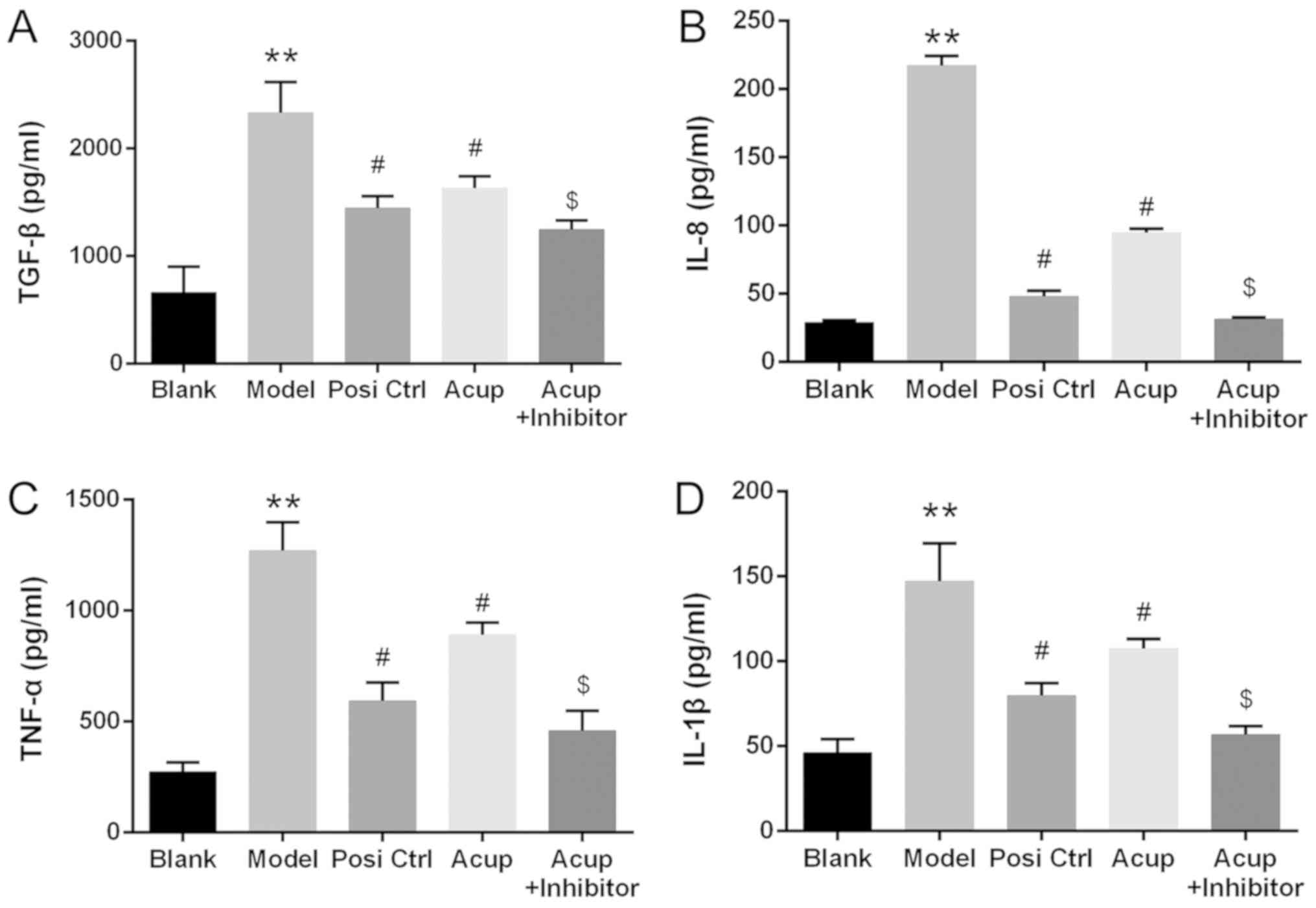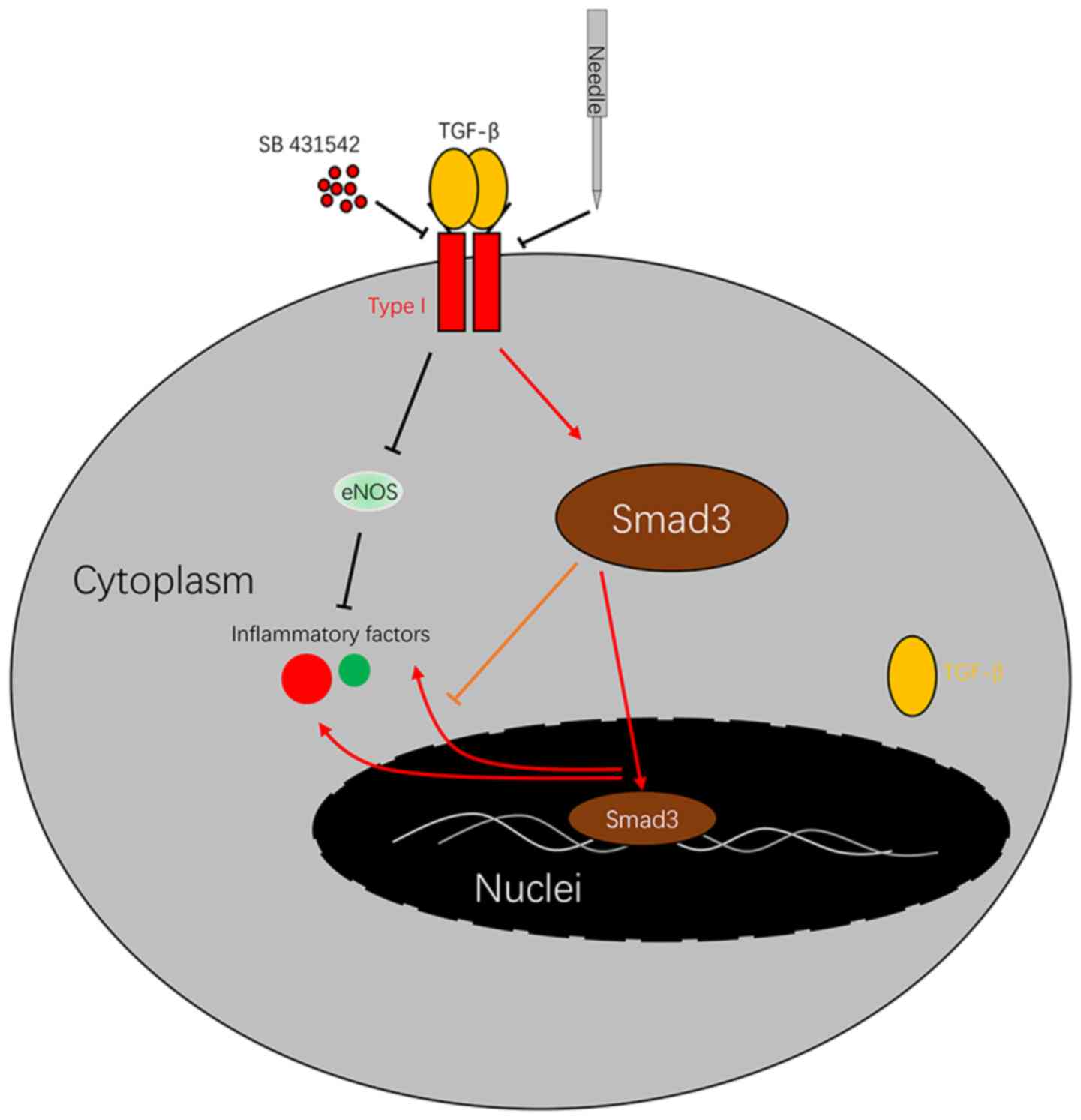|
1
|
Alsahli M and Gerich JE: Hypoglycemia,
chronic kidney disease, and diabetes mellitus. Mayo Clin Proc.
89:1564–1571. 2014. View Article : Google Scholar : PubMed/NCBI
|
|
2
|
Jha V, Garcia-Garcia G, Iseki K, Li Z,
Naicker S, Plattner B, Saran R, Wang AY and Yang CW: Chronic kidney
disease: Global dimension and perspectives. Lancet. 382:260–272.
2013. View Article : Google Scholar : PubMed/NCBI
|
|
3
|
Levey AS and Coresh J: Chronic kidney
disease. Lancet. 379:165–180. 2012. View Article : Google Scholar : PubMed/NCBI
|
|
4
|
Hill NR, Fatoba ST, Oke JL, Hirst JA,
O'Callaghan CA, Lasserson DS and Hobbs FD: Global prevalence of
chronic kidney disease-a systematic review and meta-analysis. PLoS
One. 11:e01587652016. View Article : Google Scholar : PubMed/NCBI
|
|
5
|
Farris AB and Colvin RB: Renal
interstitial fibrosis: Mechanisms and evaluation. Curr Opin Nephrol
Hypertens. 21:289–300. 2012. View Article : Google Scholar : PubMed/NCBI
|
|
6
|
Garber SL, Mirochnik Y, Brecklin CS,
Unemori EN, Singh AK, Slobodskoy L, Grove BH, Arruda JA and Dunea
G: Relaxin decreases renal interstitial fibrosis and slows
progression of renal disease. Kidney Int. 59:876–882. 2001.
View Article : Google Scholar : PubMed/NCBI
|
|
7
|
Lovisa S, LeBleu VS, Tampe B, Sugimoto H,
Vadnagara K, Carstens JL, Wu CC, Hagos Y, Burckhardt BC,
Pentcheva-Hoang T, et al: Epithelial-to-mesenchymal transition
induces cell cycle arrest and parenchymal damage in renal fibrosis.
Nat Med. 21:998–1009. 2015. View
Article : Google Scholar : PubMed/NCBI
|
|
8
|
Xie XS, Zuo C, Zhang ZY, Liu HC, Feng SG,
Zhang CL, Yuan W and Fan JM: Investigate the effects of compound
radix notoginseng on renal interstitial fibrosis and
kidney-targeting treatment. Sichuan Da Xue Xue Bao Yi Xue Ban.
43:28–33. 2012.(In Chinese). PubMed/NCBI
|
|
9
|
Naito Y, Fujii A, Sawada H, Oboshi M,
Iwasaku T, Okuhara Y, Morisawa D, Eguchi A, Hirotani S and Masuyama
T: Association between renal iron accumulation and renal
interstitial fibrosis in a rat model of chronic kidney disease.
Hypertens Res. 38:463–470. 2015. View Article : Google Scholar : PubMed/NCBI
|
|
10
|
Menn-Josephy H, Lee CS, Nolin A, Christov
M, Rybin DV, Weinberg JM, Henderson J, Bonegio R and Havasi A:
Renal interstitial fibrosis: An imperfect predictor of kidney
disease progression in some patient cohorts. Am J Nephrol.
44:289–299. 2016. View Article : Google Scholar : PubMed/NCBI
|
|
11
|
Lovisa S, Zeisberg M and Kalluri R:
Partial epithelial-to-mesenchymal transition and other new
mechanisms of kidney fibrosis. Trends Endocrinol Metab. 27:681–695.
2016. View Article : Google Scholar : PubMed/NCBI
|
|
12
|
He W, Dai C, Li Y, Zeng G, Monga SP and
Liu Y: Wnt/beta-catenin signaling promotes renal interstitial
fibrosis. J Am Soc Nephrol. 20:765–776. 2009. View Article : Google Scholar : PubMed/NCBI
|
|
13
|
Omori H, Kawada N, Inoue K, Ueda Y,
Yamamoto R, Matsui I, Kaimori J, Takabatake Y, Moriyama T, Isaka Y
and Rakugi H: Use of xanthine oxidase inhibitor febuxostat inhibits
renal interstitial inflammation and fibrosis in unilateral ureteral
obstructive nephropathy. Clin Exp Nephrol. 16:549–556. 2012.
View Article : Google Scholar : PubMed/NCBI
|
|
14
|
Irita J, Okura T, Jotoku M, Nagao T,
Enomoto D, Kurata M, Desilva VR, Miyoshi K, Matsui Y, Uede T, et
al: Osteopontin deficiency protects against aldosterone-induced
inflammation, oxidative stress, and interstitial fibrosis in the
kidney. Am J Physiol Renal Physiol. 301:F833–F844. 2011. View Article : Google Scholar : PubMed/NCBI
|
|
15
|
Tampe B and Zeisberg M: Evidence for the
involvement of epigenetics in the progression of renal
fibrogenesis. Nephrol Dial Transplant. 29 (Suppl 1):i1–i8. 2014.
View Article : Google Scholar : PubMed/NCBI
|
|
16
|
Meng XM, Tang PM, Li J and Lan HY:
TGF-β/Smad signaling in renal fibrosis. Front Physiol. 6:822015.
View Article : Google Scholar : PubMed/NCBI
|
|
17
|
Heldin CH and Moustakas A: Role of Smads
in TGFβ signaling. Cell Tissue Res. 347:21–36. 2012. View Article : Google Scholar : PubMed/NCBI
|
|
18
|
Macias MJ, Martin-Malpartida P and
Massagué J: Structural determinants of Smad function in TGF-beta
signaling. Trends Biochem Sci. 40:296–308. 2015. View Article : Google Scholar : PubMed/NCBI
|
|
19
|
Shi Y and Massagué J: Mechanisms of
TGF-beta signaling from cell membrane to the nucleus. Cell.
113:685–700. 2003. View Article : Google Scholar : PubMed/NCBI
|
|
20
|
Hwangbo C, Tae N, Lee S, Kim O, Park OK,
Kim J, Kwon SH and Lee JH: Syntenin regulates TGF-β1-induced Smad
activation and the epithelial-to-mesenchymal transition by
inhibiting caveolin-mediated TGF-β type I receptor internalization.
Oncogene. 35:389–401. 2016. View Article : Google Scholar : PubMed/NCBI
|
|
21
|
Kang JS, Liu C and Derynck R: New
regulatory mechanisms of TGF-beta receptor function. Trends Cell
Biol. 19:385–394. 2009. View Article : Google Scholar : PubMed/NCBI
|
|
22
|
Zhuang Y, Xing JJ, Li J, Zeng BY and Liang
FR: History of acupuncture research. Int Rev Neurobiol. 111:1–23.
2013. View Article : Google Scholar : PubMed/NCBI
|
|
23
|
Lan L, Zeng F, Liu GJ, Ying L, Wu X, Liu M
and Liang FR: Acupuncture for functional dyspepsia. Cochrane
Database Syst Rev. CD0084872014.PubMed/NCBI
|
|
24
|
Haddad NE and Palesh O: Acupuncture in the
treatment of cancer-related psychological symptoms. Integr Cancer
Ther. 13:371–385. 2014. View Article : Google Scholar : PubMed/NCBI
|
|
25
|
Amezaga Urruela M and Suarez-Almazor ME:
Acupuncture in the treatment of rheumatic diseases. Curr Rheumatol
Rep. 14:589–597. 2012. View Article : Google Scholar : PubMed/NCBI
|
|
26
|
Li Z, Li M, Li X, Zhang M, Zhao Y, Ren W,
Cheng J and Wang X: Hyperbaric oxygen inhibits venous neointimal
hyperplasia following arteriovenous fistulization. Int J Mol Med.
39:1299–1306. 2017. View Article : Google Scholar : PubMed/NCBI
|
|
27
|
Livak KJ and Schmittgen TD: Analysis of
relative gene expression data using real-time quantitative PCR and
the 2(-Delta Delta C(T)) method. Methods. 25:402–408. 2001.
View Article : Google Scholar : PubMed/NCBI
|
|
28
|
Chawla LS, Amdur RL, Amodeo S, Kimmel PL
and Palant CE: The severity of acute kidney injury predicts
progression to chronic kidney disease. Kidney Int. 79:1361–1369.
2011. View Article : Google Scholar : PubMed/NCBI
|
|
29
|
Muller GA, Markovic-Lipkovski J and
Rodemann HP: The progression of renal diseases: On the pathogenesis
of renal interstitial fibrosis. Klin Wochenschr. 69:576–586. 1991.
View Article : Google Scholar : PubMed/NCBI
|
|
30
|
Mian AN and Schwartz GJ: Measurement and
estimation of glomerular filtration rate in children. Adv Chronic
Kidney Dis. 24:348–356. 2017. View Article : Google Scholar : PubMed/NCBI
|
|
31
|
Hall JA, Yerramilli M, Obare E, Yerramilli
M, Yu S and Jewell DE: Comparison of serum concentrations of
symmetric dimethylarginine and creatinine as kidney function
biomarkers in healthy geriatric cats fed reduced protein foods
enriched with fish oil, L-carnitine, and medium-chain
triglycerides. Vet J. 202:588–596. 2014. View Article : Google Scholar : PubMed/NCBI
|
|
32
|
Kim DD, Pica AM, Durán RG and Durán WN:
Acupuncture reduces experimental renovascular hypertension through
mechanisms involving nitric oxide synthases. Microcirculation.
13:577–585. 2006. View Article : Google Scholar : PubMed/NCBI
|
|
33
|
Huang CL, Tsai PS, Wang TY, Yan LP, Xu HZ
and Huang CJ: Acupuncture stimulation of ST36 (Zusanli) attenuates
acute renal but not hepatic injury in lipopolysaccharide-stimulated
rats. Anesth Analg. 104:646–654. 2007. View Article : Google Scholar : PubMed/NCBI
|
|
34
|
Liu J, Song KH, You MJ, Son DS, Cho SW and
Kim DH: The effect of oculo-acupuncture on recovery from ethylene
glycol-induced acute renal injury in dogs. Am J Chin Med.
35:241–250. 2007. View Article : Google Scholar : PubMed/NCBI
|
|
35
|
Tsay SL: Acupressure and fatigue in
patients with end-stage renal disease-a randomized controlled
trial. Int J Nurs Stud. 41:99–106. 2004. View Article : Google Scholar : PubMed/NCBI
|
|
36
|
Bender BG, Leung SB and Leung DY:
Actigraphy assessment of sleep disturbance in patients with atopic
dermatitis: An objective life quality measure. J Allergy Clin
Immunol. 111:598–602. 2003. View Article : Google Scholar : PubMed/NCBI
|
|
37
|
Zhang SP, Yip TP and Li QS: Acupuncture
treatment for plantar fasciitis: A randomized controlled trial with
six months follow-up. Evid Based Complement Alternat Med.
2011:1541082011. View Article : Google Scholar : PubMed/NCBI
|
|
38
|
Chen S, Xu M, Li H, Liang J, Yin L, Liu X,
Jia X, Zhu F, Wang D, Shi X and Zhao L: Acupuncture at the Taixi
(KI3) acupoint activates cerebral neurons in elderly patients with
mild cognitive impairment. Neural Regen Res. 9:1163–1168. 2014.
View Article : Google Scholar : PubMed/NCBI
|
|
39
|
Li P, Chen YZ, Lin HL, Ni ZH, Zhan YL,
Wang R, Yang HT, Fang JA, Wang NS, Li WG, et al: Abelmoschus
manihot-a traditional Chinese medicine versus losartan potassium
for treating IgA nephropathy: Study protocol for a randomized
controlled trial. Trials. 18:1702017. View Article : Google Scholar : PubMed/NCBI
|
|
40
|
Cao Q, Harris DC and Wang Y: Macrophages
in kidney injury, inflammation, and fibrosis. Physiology
(Bethesda). 30:183–194. 2015.PubMed/NCBI
|
|
41
|
Meng XM, Nikolic-Paterson DJ and Lan HY:
Inflammatory processes in renal fibrosis. Nat Rev Nephrol.
10:493–503. 2014. View Article : Google Scholar : PubMed/NCBI
|
|
42
|
Eddy AA: Overview of the cellular and
molecular basis of kidney fibrosis. Kidney Int Suppl (2011). 4:2–8.
2014. View Article : Google Scholar : PubMed/NCBI
|
|
43
|
Grande MT, Sánchez-Laorden B, López-Blau
C, De Frutos CA, Boutet A, Arévalo M, Rowe RG, Weiss SJ,
López-Novoa JM and Nieto MA: Snail1-induced partial
epithelial-to-mesenchymal transition drives renal fibrosis in mice
and can be targeted to reverse established disease. Nat Med.
21:989–997. 2015. View Article : Google Scholar : PubMed/NCBI
|
|
44
|
Genovese F, Manresa AA, Leeming DJ,
Karsdal MA and Boor P: The extracellular matrix in the kidney: A
source of novel non-invasive biomarkers of kidney fibrosis?
Fibrogenesis Tissue Repair. 7:42014. View Article : Google Scholar : PubMed/NCBI
|
|
45
|
Urban ML, Manenti L and Vaglio A:
Fibrosis-a common pathway to organ injury and failure. N Engl J
Med. 373:95–96. 2015. View Article : Google Scholar : PubMed/NCBI
|
|
46
|
Rockey DC, Bell PD and Hill JA: Fibrosis-a
common pathway to organ injury and failure. N Engl J Med.
373:962015.PubMed/NCBI
|
|
47
|
Lan HY and Chung AC: TGF-β/Smad signaling
in kidney disease. Semin Nephrol. 32:236–243. 2012. View Article : Google Scholar : PubMed/NCBI
|
|
48
|
Neelisetty S, Alford C, Reynolds K,
Woodbury L, Nlandu-Khodo S, Yang H, Fogo AB, Hao CM, Harris RC,
Zent R and Gewin L: Renal fibrosis is not reduced by blocking
transforming growth factor-β signaling in matrix-producing
interstitial cells. Kidney Int. 88:503–514. 2015. View Article : Google Scholar : PubMed/NCBI
|
|
49
|
Shen N, Lin H, Wu T, Wang D, Wang W, Xie
H, Zhang J and Feng Z: Inhibition of TGF-β1-receptor
posttranslational core fucosylation attenuates rat renal
interstitial fibrosis. Kidney Int. 84:64–77. 2013. View Article : Google Scholar : PubMed/NCBI
|
|
50
|
Li J, Zhang Z, Wang D, Wang Y, Li Y and Wu
G: TGF-beta 1/Smads signaling stimulates renal interstitial
fibrosis in experimental AAN. J Recept Signal Transduct Res.
29:280–285. 2009. View Article : Google Scholar : PubMed/NCBI
|
|
51
|
Ning XH, Ge XF, Cui Y and An HX:
Ulinastatin inhibits unilateral ureteral obstruction-induced renal
interstitial fibrosis in rats via transforming growth factor β
(TGF-β)/Smad signalling pathways. Int Immunopharmacol. 15:406–413.
2013. View Article : Google Scholar : PubMed/NCBI
|
|
52
|
He T, Bai X, Yang L, Fan L, Li Y, Su L,
Gao J, Han S and Hu D: Loureirin B inhibits hypertrophic scar
formation via inhibition of the TGF-β1-ERK/JNK pathway. Cell
Physiol Biochem. 37:666–676. 2015. View Article : Google Scholar : PubMed/NCBI
|
|
53
|
Wickström SA, Lange A, Montanez E and
Fässler R: The ILK/PINCH/parvin complex: The kinase is dead, long
live the pseudokinase! EMBO J. 29:281–291. 2010. View Article : Google Scholar : PubMed/NCBI
|
|
54
|
Vi L, de Lasa C, DiGuglielmo GM and
Dagnino L: Integrin-linked kinase is required for TGF-β1 induction
of dermal myofibroblast differentiation. J Invest Dermatol.
131:586–593. 2011. View Article : Google Scholar : PubMed/NCBI
|
|
55
|
Su Y: Regulation of endothelial nitric
oxide synthase activity by protein-protein interaction. Curr Pharm
Des. 20:3514–3520. 2014. View Article : Google Scholar : PubMed/NCBI
|
|
56
|
García C, Nuñez-Anita RE, Thebault S,
Arredondo Zamarripa D, Jeziorsky MC, Martínez de la Escalera G and
Clapp C: Requirement of phosphorylatable endothelial nitric oxide
synthase at Ser-1177 for vasoinhibin-mediated inhibition of
endothelial cell migration and proliferation in vitro. Endocrine.
45:263–270. 2014. View Article : Google Scholar : PubMed/NCBI
|
|
57
|
Inoue N, Venema RC, Sayegh HS, Ohara Y,
Murphy TJ and Harrison DG: Molecular regulation of the bovine
endothelial cell nitric oxide synthase by transforming growth
factor-beta 1. Arterioscler Thromb Vasc Biol. 15:1255–1261. 1995.
View Article : Google Scholar : PubMed/NCBI
|
|
58
|
Saura M, Zaragoza C, Cao W, Bao C,
Rodríguez-Puyol M, Rodríguez-Puyol D and Lowenstein CJ: Smad2
mediates transforming growth factor-beta induction of endothelial
nitric oxide synthase expression. Circ Res. 91:806–813. 2002.
View Article : Google Scholar : PubMed/NCBI
|
|
59
|
Paterniti I, Esposito E, Mazzon E,
Bramanti P and Cuzzocrea S: Evidence for the role of
PI(3)-kinase-AKT-eNOS signalling pathway in secondary inflammatory
process after spinal cord compression injury in mice. Eur J
Neurosci. 33:1411–1420. 2011. View Article : Google Scholar : PubMed/NCBI
|



